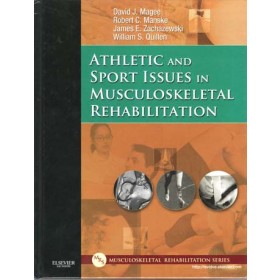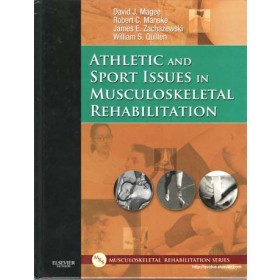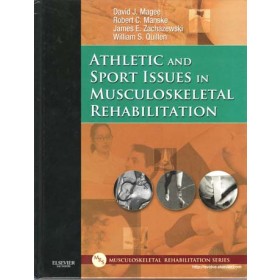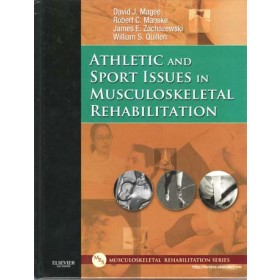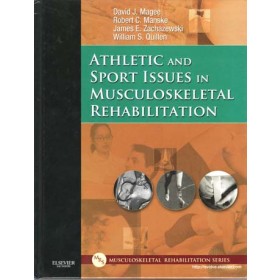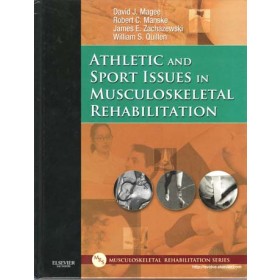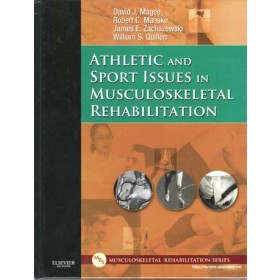Details
Athletic and Sport Issues in Musculoskeletal Rehabilitation: Module 7 (Electronic Download)
SKU: 757E
by David J. Magee, PT, PhD, Robert C. Manske, PT, DPT, SCS, Med, ATC, CSCS, James E. Zachazewski, PT, DPT, SCS, ATC, and William S. Quillen, PT, PhD, SCS, FACSM
These courses are offered in cooperation with Elsevier Health and utilize the textbook, “Athletic and Sport Issues in Musculoskeletal Rehabilitation” by David J. Magee, PT, PhD, Robert C. Manske, PT, DPT, SCS, Med, ATC, CSCS, James E. Zachazewski, PT, DPT, SCS, ATC, and William S. Quillen, PT, PhD, SCS, FACSM.
These courses provide expert insight and clear rehabilitation guidelines to help you manage injuries and special medical needs unique to your athletic clients. Contributions from leading physical therapists, athletic trainers, physicians and orthopedic surgeons give you a comprehensive, clinically relevant understanding of common sports-related injuries and help you ensure the most effective therapeutic outcomes. These courses are essential to everyone on the sports medicine team!
Module 1: covers preparation and prevention in sports medicine including the role of the sports medicine team, pre-participation physical fitness profiling, psychosocial aspects of youth sports and nutrition counseling and athletes.
Module 2: covers preparation and prevention in sports medicine including environmental considerations for sports, use of ergogenic aids in sports and sports drug testing issues
Module 3: covers applied biomechanics of cycling, golf, jumping and tennis
Module 4: covers applied biomechanics of soccer, running, swimming and baseball pitching
Module 5: covers management of sports injury and illness including delayed-onset muscle soreness, medical conditions in sport, dermatologic considerations in athletics and protective equipment in sports
Module 6: covers management of sports injury and illness including sports related concussions, traumatic injuries to the cervical spine, maxillofacial injuries and abdominal and thoracic injuries.
Module 7: covers special populations and epidemiology including the female athlete, musculoskeletal dance medicine and science, the athlete with disabilities, and selected rehabilitation needs of the masters athlete.
Module 8: covers applied biomechanics of common weight training exercises, taping for athletics and rehabilitation and applied sports injury epidemiology
Order this product and it will be available to you immediately after purchase for electronic download in the “My Downloads” section of your account after you have logged in. The download files will require Adobe Acrobat Reader to open. If you do not have Adobe Acrobat installed, you may download it at no charge from Adobe.com.
Course Length: 8.0 contact hours
Instructional level: Intermediate
This package contains the reading and testing materials for Module 7 only.
Athletic and Sport Issues in Musculoskeletal Rehabilitation: Module 7
Course Goals and Objectives:
Course Goals: This course is intended to instruct the student through self paced study on the foundation of treating special populations in athletics including the female athlete, dance medicine, an athlete with disability, and rehabilitation of the masters athlete.
Student Objectives:
At the end of this course, the student will be able to:
1. Understand the musculoskeletal differences between males and females.
2. Analyze female basketball/soccer players and the rate of ACL injury.
3. Analyze four factors that contribute to ACL injury.
4. Understand the relationship of the female menstrual cycle and ACL tears.
5. Evaluate the Q-angle in the lower extremity.
6. Analyze four muscles as they relate to medial tibial stress syndrome.
7. Understand the correct treatment for MTSS.
8. Understand common locations for spondylolisthesis.
9. Evaluate the relationship of SI dysfunction and lumbar motions.
10. Understand the difference between structural and functional scoliosis.
11. Understand the female athlete triad.
12. Analyze female bone mineral density and age.
13. Understand the exercise parameters for an elite pregnant athlete.
14. Analyze four conditions and exercise during pregnancy.
15. Evaluate four body parts and their likelihood to be injured during dance.
16. Understand the type of dance that will most often cause overuse injuries.
17. Evaluate the anterior talofibular ligament as it relates to different dance positions.
18. Understand the dance position with the greatest potential for injury to the foot.
19. Analyze lower extremity kinematics as it relates to turnout.
20. Understand the relationship of an anteverted/retroverted femoral neck and dancing postures.
21. Evaluate the pain pattern of an os trigonum/steida process in the foot.
22. Evaluate several types of foot fractures common in dance.
23. Understand the biomechanical processes of external hip snapping.
24. Evaluate the differences between a qualitative and quantitative biomechanical analysis.
25. Understand emergency procedures related to autonomic dysreflexia.
26. Analyze the potential for injury for a runner with a below knee amputation.
27. Analyze several medical conditions and their relationship to core body temperature.
28. Understand ideal fluid replacement in athletics.
29. Understand the body’s normal response to aging as it relates to muscle fiber type.
30. Understand the decline of flexibility in the masters athlete.
31. Understand the mechanical processes of knee osteoarthritis.
32. Analyze primary osteoarthritis of the shoulder and its causes.
33. Evaluate four sports and the possibility for an individual with a total hip arthroplasty to participate in those sports.
34. Analyze four sports and the possibility of an individual to participate in them after total shoulder arthroplasty.
